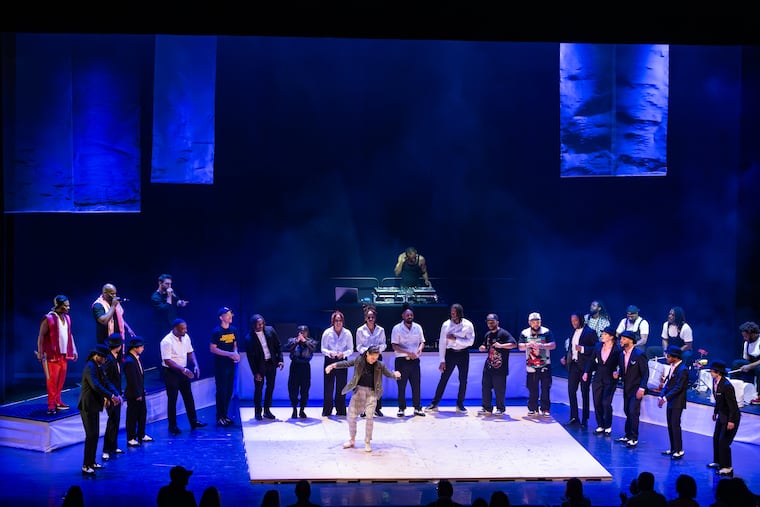Rennie Harris’ ‘American Street Dancer’ is a vibrant celebration of community music and dance
Exceptionally talented dancers and musicians focus on regional street-dance styles: jit from Detroit, footwork from Chicago, and Philadelphia’s own GQ.

Thrilling, educational, and unexpectedly moving — Rennie Harris’ American Street Dancer, which received its world premiere Friday night at the Annenberg Center, is all that … and more. Commissioned as part of Harris’ three-year residency with Penn Live Arts, American Street Dancer is a complex and ambitious work.
In it, 20 exceptionally talented dancers and eight equally remarkable musicians focus on a trio of regional street-dance styles: jit from Detroit, footwork from Chicago, and Philadelphia’s own GQ.
In a preperformance chat, Harris stressed that street dance is not the same as hip-hop, which developed later and is danced exclusively to hip-hop music. In contrast, various communities have their own styles of street dance, each performed to a variety of musical genres. Harris added that he created this program to honor the pioneers of street dance, whose contributions have often been forgotten, and to demonstrate the mutual influences of various types of percussive dance (where feet and hands make the rhythm).
To further emphasize the concept of legacy, videographer/lighting designer Julie Ballard projects a series of vintage photos and film clips onto the rear wall of the stage.
For audience members unfamiliar with the distinctions among jit, footwork, and GQ, the printed program provides helpful explanations. But, even without prior knowledge of these forms, the short segments — each represented by local experts (Michael Manson’s House of Jit, Creation Global with footwork-style choreography by Eddie Martin, and Harris’s own troupe: Rennie Harris Puremovement) — are easy to appreciate.
And the solo performed by tap-dance virtuoso Ayodele Casel is a master class in the myriad ways the human foot can move to create its own music. Whether Casel is executing graceful slides, emphatic jumps, or delicate toe-stutters, her command of rhythm — at all speeds — is mesmerizing.
The artist biographies reveal impressively varied backgrounds: The dancers tour and teach all over the world, studying dance and criminal justice, and collecting numerous awards, while using their skills to work toward social change. The dancers have top-notch technique, plus the ability to handle both challenging unison work and improvisational solos.
While each dance style received an enthusiastic response, it was GQ — presented by Harris’ company — that brought the audience to its feet. Reportedly named after the men’s magazine, GQ has its roots in Philadelphia’s Black social clubs of the 1960s, where the cha-cha was a popular couple dance. For his version, Harris borrows the basic cha-cha rhythm, dresses his dancers in elegant black suits with white shirts and bowler hats (vs. the more casual, uncredited costumes worn in other numbers), and sometimes has them move in groups of two.
Harris’ GQ is his own — full of exciting choreographic invention. Watching the members of RHPM, it was impossible to distinguish apprentices from principal dancers. It was also difficult to identify individuals, but Zakhele “Swazi” Grabowski stood out due to his acrobatic abilities.
Of course, dance is just one element of this performance, complemented by the Rennie Harris Hip-Hop Orchestra. Master drummer Brytiece Wallace opens the show with a percussion-inspired solo, then joins the three bucket drummers (Tony Royster, Edward Smallwood, and Solomon Saunders) for several dramatic sequences. Beatboxers Akim Funk Buddha, also trained in Mongolian throat-singing; Alexander Sanchez; and the justly famous Kenny Muhammad (a.k.a. “The Human Orchestra”) are astonishing.
Holding mics in one hand and gesturing with the other, they produce combinations of sounds that seem well beyond the range of the human vocal apparatus. A crowd favorite was turntablist DJ Razor Ramon. He began with standard DJ moves (e.g., “scratching” vinyl records) but segued to manipulating the discs with his head, or standing with his back to the turntables, and — in a final flourish — removing his T-shirt with one hand, all without missing a beat.
None of this would be possible without the wizardry of RHPM’s Bessie Award-winning composer, music editor, and live sound designer, Darrin M. Ross. It is Ross who ensures that the very different sounds produced by the dancers, drummers, beatboxers, and turntablist — plus occasional recordings of voices and flowing water — maintain the proper balance.
The evening ends quietly, with an African-inspired song, and a projected text: “In Memory of Dave the Renegade,” a member of the pioneering Philadelphia hip-hop dance group the Scanner Boys, with whom Harris performed during the 1980s.
A few of the transitions between segments could have been crisper, and Harris’ prerecorded comments were sometimes difficult to understand. But American Street Dancer does what it set out to do: celebrate vibrant and varied traditions of community music and dance, while — not just incidentally — reminding viewers of the essential contributions made by female performers to this fast-paced, competitive art form.
Rennie Harris Puremovement in “American Street Dancer” at the Annenberg Center’s Zellerbach Theatre, 3680 Walnut St., through Saturday (2 p.m. and 8 p.m.) Tickets: $47 - $79; (215) 898-3900; annenbergcenter.org.